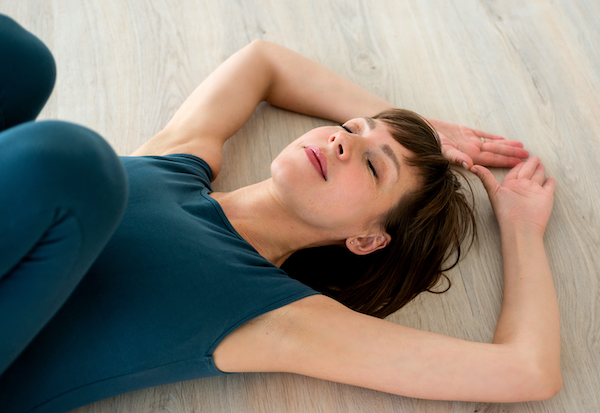
Table of Contents
What is Somatic Yoga?
Somatic Yoga is a type of yoga that emphasizes internal experience and body awareness. It is a physical practice that involves moving the body in a way that is both mindful and intuitive. Somatic Yoga is based on the concept of Soma, which means body in Greek. This practice is designed to help you tap into your intuition and move in a way that feels natural and authentic to your body.
In Somatic Yoga, the focus is on the internal experience of the body rather than the external appearance. This means that you are encouraged to pay attention to the sensations in your body, such as tension, tightness, or discomfort. By doing so, you can begin to develop a deeper understanding of your body and how it moves.
Somatic Yoga is different from traditional yoga practices in that it is not about achieving a perfect pose or a certain level of flexibility. Instead, it is about exploring the body’s natural movements and finding ways to move that feel good and nourishing to you. It is a practice that is accessible to people of all ages and abilities.
It is one of many somatic practices that are designed to help you get to know yourself more intimately. It is a safe and informed practice that responds to your ever-changing needs as a dynamic organism. By reclaiming the ability to make your own choices about your body, you can create positive changes in your physical, emotional, and mental well-being.
Why Practice Somatic Yoga?
If you’re looking for a yoga practice that emphasizes your internal experience, somatic yoga sounds like the right one for you. It is a therapeutic approach to yoga that focuses on cultivating awareness of your body and movement patterns. It can help you feel more emotionally aligned and empowered and may offer a range of benefits for your physical and mental health.
By tuning into your body’s sensations and exploring movement in a mindful way, you can become more attuned to your body’s needs and limitations. This increased awareness can help you make more informed choices about your practice, and may also help you move with greater ease and efficiency throughout your daily life.
This practice can also be a powerful tool for healing and rehabilitation. By practicing somatic exercises that focus on specific areas of the body, you can help reduce pain and tension, improve range of motion, and promote healing. Additionally, somatic yoga may help you develop greater control over your body, which can be particularly helpful if you’re recovering from an injury or illness.
In addition to its physical benefits, it can also be a source of joy and self-discovery. By exploring movement in a playful and curious way, you can tap into a sense of childlike wonder and creativity. Moreover, somatic yoga can help you develop a deeper connection with your body and a greater sense of self-awareness, which can be incredibly empowering.
Philosophy of Somatic Yoga
Somatic yoga is a practice that emphasizes the mind-body connection and promotes self-healing through movement and touch. At its core, it is about mindfulness and being present in the moment. By bringing awareness to the sensations within your body, you can tap into your innate ability to heal and transform.
The philosophy of somatics was originally developed by Thomas Hanna in the 1970s. Hanna believed that by reawakening the mind’s control of movement, flexibility, and health, we could improve our physical and emotional well-being. He saw somatics as a way to help people overcome chronic pain and tension, and to develop a deeper sense of embodied awareness.
Eleanor Criswell and Bonnie Bainbridge Cohen are two other pioneers in the field of somatics. Criswell was Hanna’s student and helped develop the first somatic yoga teacher training program. Cohen founded the School for Body-Mind Centering, which incorporates somatic principles into movement education.
Somatic yoga draws on a variety of other practices and philosophies, including:
- The Alexander Technique, a method of movement re-education that emphasizes the relationship between the head, neck, and spine. By becoming more aware of these connections, you can improve your posture, breathing, and overall sense of well-being.
- Patanjali’s Yoga Sutras, a concise text written by the sage Patanjali, that outlines the principles and practices of classical yoga. It comprises 196 aphorisms that explore the nature of consciousness, the path to liberation, and techniques for achieving mental clarity and spiritual enlightenment.
- The concept of embodiment, which refers to the idea that our bodies are not just physical vessels, but also the means through which we experience the world. By cultivating a deeper sense of embodiment, we can become more connected to ourselves and to the world around us.
Overall, the philosophy of somatic yoga is transformative. By bringing awareness to our bodies and our movements, we can tap into our innate capacity for healing and growth. Whether you are new to yoga or an experienced practitioner, it can help you develop a deeper sense of embodied awareness and transform your relationship with your body and mind.
Key Principles Of Somatic Yoga
Awareness of Patterns
In this type of yoga, the focus is on becoming aware of your habitual movement patterns and learning to move more efficiently. By becoming aware of these patterns, you can begin to release tension and move with greater ease. This awareness can also help you to prevent injuries and improve your overall range of motion.
Breath and Movement
Breath is an essential part of somatic yoga. By coordinating your breath with movement, you can deepen your practice and improve your overall well-being. The breath is used to help you become more aware of your body and to release tension.
Learning Through Touch
Somatic yoga often involves the use of touch to help you become more aware of your body. By working with a teacher or partner, you can learn to release tension and move more efficiently. This touch can also help you to develop a deeper understanding of your body and to improve your range of motion.
Sensory Feedback
In somatic yoga, the focus is on developing a deeper awareness of your body. By paying attention to the sensory feedback from your body, you can learn to move more efficiently and release tension. This awareness can also help you to prevent injuries and improve your overall range of motion.
Somatic Technique
Somatic techniques are used in somatic yoga to help you release tension and move more efficiently. These techniques involve gentle movements and stretches that are designed to help you become more aware of your body and to release tension.
Alignment and Transitions
Alignment and transitions are the focus of this practice. By paying attention to your alignment, you can prevent injuries and improve your overall range of motion. Transitions are also important, as they help you to move more efficiently and with greater ease.
Beginners and Experienced Practitioners
Somatic yoga is suitable for both beginners and experienced practitioners. Beginners can learn to become more aware of their bodies and to release tension, while experienced practitioners can deepen their practice and improve their overall range of motion.
Muscles and Nervous System
In somatic yoga, the focus is on the muscles and nervous system. By releasing muscle tension, you can improve your overall range of motion and prevent injuries. The nervous system is also important in somatic yoga, as it helps to regulate the body’s response to stress and tension.
Understanding the Relevance of Interoception
Interoception is the ability to perceive and understand the internal sensations of your body, including hunger, thirst, pain, and emotional states. It is a crucial aspect of any somatic practice, as it allows you to connect with your body and develop a deeper understanding of your internal experience.
By cultivating interoception, you can develop a more mindful approach to your somatic yoga practice, which can help you to tune in to the subtle sensations of your body and respond to them with greater awareness and sensitivity. This can lead to a more profound sense of body awareness and a greater understanding of the relationship between your physical and emotional experiences.
Meditation is a powerful tool for developing interoception, as it allows you to focus your attention on your internal experience and cultivate a sense of presence and awareness. By incorporating meditation into your somatic yoga practice, you can enhance your ability to connect with your body and develop a deeper understanding of your internal experience.
Somatic Yoga Benefits
Physical Benefits
Somatic yoga can help improve joint mobility, strength, and posture. It can also reduce neuromuscular pain and symptoms related to chronically-tight muscles, such as headaches, frozen shoulder, and breathing difficulties. Through somatic yoga, you can create greater body awareness and learn to move with more ease and efficiency.
Somatic yoga can also be beneficial for injury rehabilitation. By focusing on the internal experience of movement, you can develop a deeper understanding of your body and its limitations. This can help you avoid re-injury and develop a more sustainable movement practice. Somatic practices have been proven to even help with chronic pain.
Mental and Emotional Benefits
In addition to physical benefits, somatic yoga can also be a powerful tool for mental and emotional well-being. By cultivating a sense of grounding and energy, somatic yoga can help reduce anxiety and depression. It can also improve concentration and provide a sense of empowerment.
Somatic yoga can be particularly beneficial for those who have experienced trauma or struggle with emotional regulation. By focusing on internal experience and developing a sense of safety in the body, somatic yoga can help promote healing and emotional resilience.
Integration with Other Modalities
Somatic yoga can be practiced on its own or integrated with other modalities, such as therapy, tai chi, or bodywork. Many somatic yoga practitioners also incorporate elements of the Feldenkrais Method or Rolfing into their practice.
Somatic yoga can be practiced in a variety of settings, including yoga studios, therapy offices, and even through outside apps on iOS devices. It can be practiced in a variety of yoga asanas, including savasana and cobra poses, and can be adapted to meet the needs of individual practitioners.
Before you go…
Now that you have learned about somatic yoga, we invite you to explore more transformative practices and deepen your yoga journey. Here are some articles from our blog that you might find interesting:
- Aqua Yoga: Main Benefits and Best 5 Poses For Beginners – If you’re looking to add a refreshing twist to your yoga practice, aqua yoga is a wonderful option. Discover the benefits of practicing yoga in the water and learn five beginner-friendly poses to get you started.
- Candlelight Restorative Yoga: A Guide to Relaxation and Renewal – Sometimes, what our bodies and minds truly need is deep relaxation and restoration. Dive into the world of candlelight restorative yoga and explore the nurturing practices that promote inner healing and renewal.
- Hot Power Vinyasa Yoga: 15 Reasons You Should Start Practicing It – If you’re ready to turn up the heat and challenge yourself, hot power vinyasa yoga might be just what you’re looking for. Uncover the 15 reasons why this dynamic and energizing practice can take your yoga experience to new heights.
Namaste!



